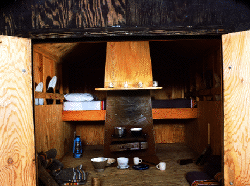Atelier van Lieshout
Camden Arts Centre, London, UK
Camden Arts Centre, London, UK

The four substantial structures included in this adventurous show went some way to demonstrating the diverse and inherently schizophrenic nature of this Dutch workshop's practice. Relying heavily on the Atelier's past exploration of the potential of mobile architecture, the show demonstrated how the early functional sculpture designed by Joep van Lieshout, mouthpiece of the AVL brand, has evolved into architecture and interior design commissions through functioning models for farms, arms factories, hospital theatres and an unusually large number of toilets.
One toilet featured prominently in this show: Compostopia (2002), an enormous framework of bare scaffolding poles, formed a combined multi-level gym, a communal bed, a raised toilet and shower unit and an open allotment. Constructed so that you climbed stairs and entered the fibreglass loo above the entire structure, effluent and excess water would flow, slide or simply 'plop' into the plant-growing area below. The ease with which the terms 'seed', 'soiled' and 'spreading' coupled with the bed sheets made its pungent and faintly chauvinistic point. It recalled Georges Bataille's theory that the rotation, from a horizontal to a vertical axis, of the mouth and the anus as entry and exit points to the body in man's effort to walk upright had repressed emphasis on the sex organs. Slapping them back in the viewers faces demonstrated the pivotal role this bodily alteration still has to play in the development of human societies.
With these thoughts in mind, the Mini Capsule Hotel Side Entrance (2002) - six fibreglass 'maxi-capsules', equipped with ventilation and entertainment systems stacked to form a pod-hotel - offered unlimited interactive potential. Clearly a development of the group's multiple sleeping compartments and mobile caravans, it differed only minimally from the tiny beehive-like compartments in Japanese capsule hotels. In the social and economic conditions proposed by AVL, however, these structures, positioned in public spaces across cities, offer a very attractive nomadic lifestyle free from issues of ownership and regulation.
Fisherman's House (1999), lurking alone in a gloomy room, successfully scuttled these optimistic thoughts by recalling much older notions of self-sufficiency. In a homage to the huts built by 19th-century frontiersmen, the rough open-ended cabin, made from reclaimed materials, inspired dark contemporary references to the survivalist mentality exemplified by individuals such as the Unabomber. AVL's stated quest 'to create an autonomous space where everything is possible within a country that is over-regulated to an increasingly oppressive degree' demonstrates a similar paranoia about state control. It's just unfortunate that the work has to take the form of an agrarian self-sufficiency or a pseudo-militaristic delight in building and using weapons that is more closely associated with the extreme conservative voices already prevalent in the US and growing recently in Europe.
This is ironic, considering the group has its origins in a country regarded by many as a model for the individual freedoms extended to its citizens. It's also slightly ludicrous because AVL-ville, the free state built last year on two muddy sites in Rotterdam's harbour - where art, sanctuary and social structure combined in a functioning community with its own city farm, a constitution, a flag and even money - was closed down by the local government after only nine months because too many people visited the site and it posed, of all things, a 'health risk'. It is thought-provoking to consider that while the exhibition was being shown the Dutch liberal consensus was already being shattered, first by the results of an investigation into the Dutch army's questionable conduct in Bosnia, then by the assassination of the right-wing party leader Pym Fortuyn.
Perhaps it is no wonder that the other structure in the show, Maxi Capsule Luxus (2002), resembled a sensory deprivation chamber. The space's unusual dimensions, dictated by an interior equipped only with the most high-tech TV and audio equipment, its walls, floor and ceiling clad in red velour, all reflected an understandable intolerance of the social interaction required by the other structures and a desire for a cleaner, more removed form of mediated participation.























